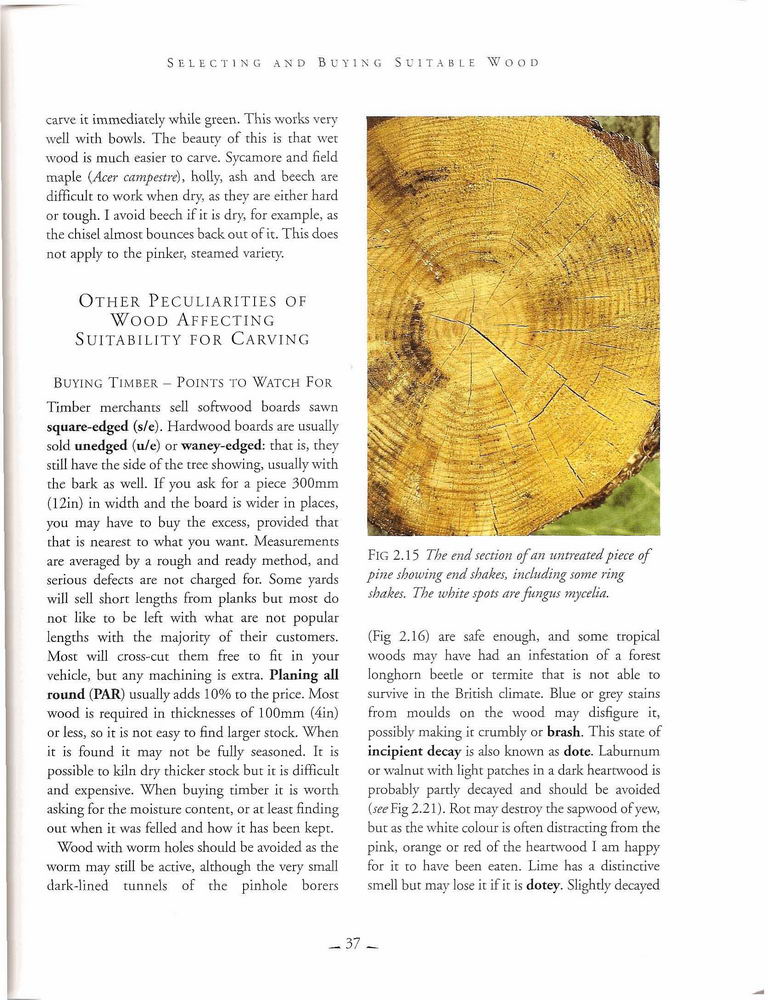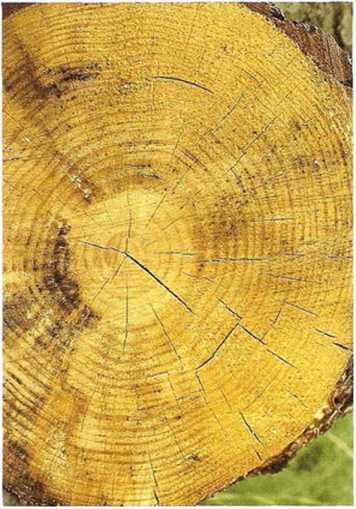essentÊrving°37

SELECTING AND B V Y 1 N C» SUITABLE W O O I)
carvc it immediatcly while green. This works vcry well with bowls. The beauty of this is that wet wood is much easier to carve. Sycamore and field mapie (Acer campestre), Koiły, ash and hecch arc difFicult co work when dry, as they are either hard or tough. 1 avoid beech if it is dry, for examplc, as the chisel almost bounces back out of it. This does not apply to the pinker, steamed variety.
Other Peculiarities OF Wood Affecting SUITABlLITY FOR CaRVING
Buying Timbf.r Points to Watch For
Timber mcrchants sell softwood boards sawn squarc-cdgcd (s/c). Hardwood boards are usually sold unedged (u/c) or waney-edged: that is, they still have the sidc of the trec showing, usually with the bark as well. If you ask for a piece 300mm (12in) in width and the board is wider in placcs, you may havc to buy the excess, provided that that is nearest to what you want. Measurements are averaged by a rough and rcady method, and serious defects are not chargcd for. Some yards will sell short lcngths from planks but most do nor like to bc Icft with what are not popular lengths with the majority of their customcrs. Most will cross-cut rhem free to fit in your vehiclc, but any machining is extra. Planing all round (PAR) usually adds 10% to the price. Most wood is recjuired in thicknesses of 1 OOmm (4in) or less, so it is not easy to find larger stock. When it is found it may not bc fully seasoned. It is possible to kiln dry thickcr stock but it is difficult and expensivc. When buying timber it is wonh asking for the moisture content, or ar least finding out when it was felled and how it has been kept.
Wood with worm holes should be avoided as the worm may still be active, although the very smali dark-lined tunncls of the pinhole borers

Fig 2.15 The end section ofdn nntreatedpiece of pine showing end shakes, inciuding some ring shakes. The wbite spots are fungus mycelia.
(Fig 2.16) are safe enough, and some tropical woods may havc had an infestation of a forest longhorn bcetle or termite that is not ablc to survive in the British climate. Blue or grcy stains from moulds on the wood may disfigure it, possibly making it crumbly or brash. This State of incipient decay is also known as dote. Laburnum or walnut with light patches in a dark hearewood is probably partly decayed and should be avoided (see Fig 2.21). Rot may destroy the sapwood of ycw, but as the white colour is often distracting from the pink, orange or red of the heartwood 1 am happy for it to have been eaten. LimÄ™ has a distinctive smell but may lose it if it is dotey. Slightly decayed
— 37 —
Wyszukiwarka
Podobne podstrony:
essent?rving?35 SELECT1NC AND B u Y I N G SflTABLE WOOI) constantly growing. It is therefore wise to
essent?rving?33 Selecting and B l v i n g Sutable W o o d Hardwood cells pjfcre parenchyma (storage
essent?rving?27 CHAPTER 2SELECTING AND BUYING SUITABLE WOOD The Beginner’s Experience Thcrc is
essent?rving?41 S E L E C T I X G AND B VV I N G SUITABLE W O O D Fic 2.22 The brown lines on the ne
ZSBD 4 SQL Server and in all databases. It is provided for backward compatibility and should not be
63 the act, mixes with the secretions, and penetrates its mother’s womb as an embryo *. It is elear,
Slide5 PRODUCE IT See the information in English (or picture) and think or say it in Polish You can
Theoretical and Methodological Problems 19 The ES area is an attractive research and application fie
With lower infection rates and morÄ™ widespread testing, it is now feasible for the EU5 nations to us
2020 IBEF Exchange SeminarMATERIALS SELECTION AND DESIGN> Materials > Emulsified Asphalt Ta
...ale można spotkać również inne opinie ! "Software Engineering" is a myth and only loser
16ddg02 emo Form for Period Selection and Product Grouping From 103/19/95 To 103/23/96 RangÄ™ Fr
interdisciplinary team of researchers and practitioners. It is explained why this type of projects s
więcej podobnych podstron